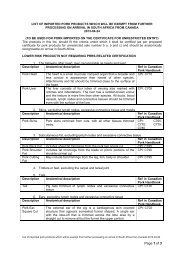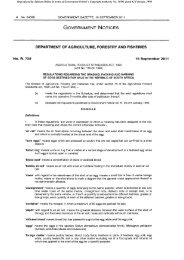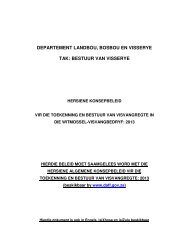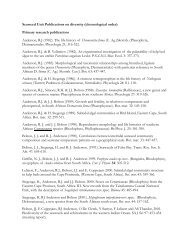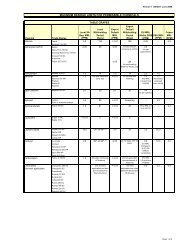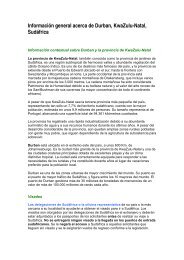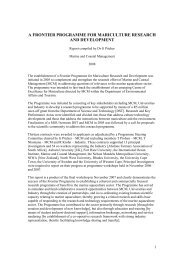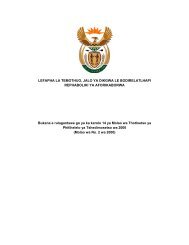You also want an ePaper? Increase the reach of your titles
YUMPU automatically turns print PDFs into web optimized ePapers that Google loves.
Examples of anemones<br />
False plum anemone Pseudactinia flagellifera<br />
The large orange false plum anemones are easy to identify<br />
because they are soft and cannot fold their tentacles inside<br />
their bodies as they lack a sphincter muscle around the<br />
mouth. They are very aggressive. If another unrelated<br />
anemone comes too close, swellings appear below the<br />
tentacles – these spherules are packed with potent stings<br />
that will injure or even kill the intruder and enable the anemone<br />
to defend its territory. The venom from the false plum<br />
anemone will affect humans, so it should not be handled.<br />
Plum anemone Actinia aquina<br />
The dark red plum anemone lives high on the<br />
s h o re. It bro o d s its young inside the body cavity<br />
and juvenile anemones crawl out of its mouth.<br />
Sandy anemone Bunodactis reynaudi<br />
The sandy anemone buds off new individuals and forms<br />
large family groups, called clones, with the same genetic<br />
composition, which live successfully together. They have<br />
sand sticking to their bodies and have an amazing array of<br />
colours – purple, pink, blue, orange, red and yellow.<br />
Striped anemone Anthothoe stimpsoni<br />
This delicate pink, green or yellowish-brown anemone has<br />
distinctive vertical stripes and is common in pools. If irritated<br />
it shoots sticky white threads of stings through its body wall.<br />
Knobbly anemone Bunodosoma capensis<br />
This is one of the most beautiful and variable species that<br />
appears in all the colours of the rainbow. It is abundant in<br />
sand-free areas and never has sand sticking to the knobbles<br />
on its surface.<br />
Giant anemones<br />
There are a few species of giant anemones living in tropical<br />
waters. These may reach 1 m in diameter and are covered<br />
with numerous tentacles. They have an interesting commensal<br />
association with clown fish that shelter among the tentacles,<br />
protected from the stings by a special coating of slime. The<br />
anemone seems to recognise its resident clown fish.<br />
Strawberry anemone Corynactis annulata<br />
These small, exquisite, transparent pink anemones have dis-<br />
tinctive pale knobs on the tips of the tentacles. They occur in<br />
Plum<br />
anemone<br />
clusters and are more closely related to corals than anemones.<br />
They feed on small organisms floating in the plankton.<br />
Zoanthids<br />
Zoanthids form vast carpets in greens, browns and purples on<br />
the rocky shores of KwaZulu-Natal. These anemone-like animals<br />
are linked together at their bases by a fleshy coenenchyme<br />
and form large colonies of interconnected individuals. They<br />
are carnivorous, but seem to gain most of their nourishment<br />
from tiny algae that live symbiotically within their bodies.<br />
Author: Margo Branch September 2000<br />
Zoanthids<br />
Classification:<br />
PHYLUM Cnidaria<br />
CLASS Anthozoa – Anemones, zoanthids and corals<br />
ORDER Actinaria – Anemones<br />
ORDER Coralliomorpha – Strawberry anemone<br />
ORDER Zoanthidea – Zoanthids<br />
FURTHER INFORMATION: • Branch, G. M. & Branch M. L. 1981. The Living Shores of Southern Africa . Struik, Cape Town.<br />
• Branch, G. M., Griffiths, C. L., Branch M. L & Beckley, L. E. 1994. Two Oceans: A guide to the marine life of southern Africa, David Philip, Claremont, Cape Town.<br />
RELATED FACTSHEETS: • Corals • Cnidarians • Jellyfish • Bluebottles • Sex Change in Fishes • Classification of Marine Life<br />
Strawberry<br />
anemone<br />
For more information, please contact: The Coastal Management Office, Marine and Coastal Management, Department of Environmental Affairs and Tourism, Private Bag X2,<br />
Roggebaai 8012, Cape Town, South Africa. Tel: +27 (0)21 402-3208 Fax: +27 (0)21 418-2582 e-mail: czm@mcm.wcape.gov.za Website: http://sacoast.wcape.gov. z a





